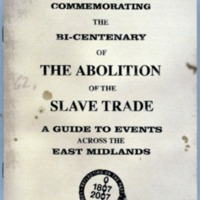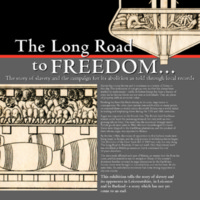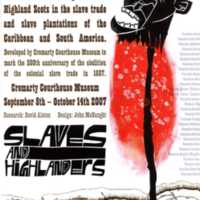
'Irreconcilable with the principles of justice and humanity': the trade in slaves and its abolition
An exhibition held in the Special Collections Gallery at the Hartley Library, University of Southampton. The exhibition took a broad view of the subject of transatlantic slavery across the 18th and 19th centuries, featuring accounts of the horrors of the transatlantic slave trade, the case for abolition, and contemporary tracts and pamphlets putting forward the arguments for total abolition. Alongside these were discussions of the place of slavery in the economy of the West Indies, and the detail of measures taken by governments, such as that of the first Duke of Wellington in 1828-30, and the work of the third Viscount Palmerston, as Foreign Secretary and Prime Minister. The exhibition also looked at the efforts of the Royal Navy to enforce legislation and treaties against slave trading.

A Guide to Events Across the East Midlands
A guide to bicentenary activities and events in museums, archives and other venues across the East Midlands - Leicestershire and Rutland, Nottinghamshire, Northamptonshire, Derbyshire and Lincolnshire - was produced by Museums, Libraries and Archives East Midlands and Renaissance East Midlands. These events commemorated local connections to the abolitionist movement and to slavery. For example, Manor House Museum in Kettering produced a loans box containing material on William Knibb, a local abolitionist. Rothwell Arts and Heritage Centre produced an exhibition on the life of Rothwell-born missionary John Smith. Derby City Museums and Gallery worked with an artist and young people to explore Derby's industrial heritage and its links to the slave trade using The Silk Mill, Derby's Museum of Industry and History, as inspiration. Chesterfield Local Studies put together a touring exhibition to explore Derbyshire connections to the slave trade. A community commemorative event organised by Lincolnshire County Council and Lincolnshire African and Caribbean Support Group included a service of remembrance and the release of 200 'Freedom' balloons from Lincoln City Square on 24 March 2007.

The Long Road to Freedom
As made clear by The Long Road to Freedom exhibition in 2007, the Record Office for Leicestershire, Leicester & Rutland contains a significant collection of documents which reveal local connections with the slave trade, and with those who campaigned for abolition. Several prominent local families owned slaves on plantations in the Caribbean and on the north coast of South America. Leading Leicester abolitionists, Elizabeth Heyrick and Susanna Watts, orchestrated a vigorous anti-slavery campaign in Leicester, including a boycott on sugar. Local landowner, Thomas Babington of Rothley Temple, was a friend of William Wilberforce and hosted meetings of anti-slavery campaigners at his home. The exhibition also highlighted a unique collection of mid-19th century papers which provide access to the voices of the enslaved in a slave court in Lagos, West Africa. It also told the stories of two former slaves, Rasselas Morjan and Edward Juba, who came to Leicestershire with their owners. This exhibition toured to various venues in the region, including Abbey Pumping Station, where it coincided with family activities focused on the work of Elizabeth Heyrick.

Slaves and Highlanders
An exhibition developed by Cromarty Courthouse Museum in the Scottish Highlands recording the role of Highland Scots in the slave trade and slave plantations of the Caribbean and South America and, in particular, British Guiana. The striking illustrations were by John McNaught. The exhibition told individual stories of Scottish merchants, plantation owners and their slaves, such as a slave called Inverness, bought, sold, exploited and hunted as a runaway by Scots in Demerara. It also looked at the freed slaves who found a place in Scottish society. Connected to this project was the placing of a plaque in the former Royal Northern Infirmary (now the executive office of the University of the Highlands and Islands). It remains one of the few acknowledgements of the use of profits from the slave plantations to fund charitable public institutions, and the only known one in Gaelic.